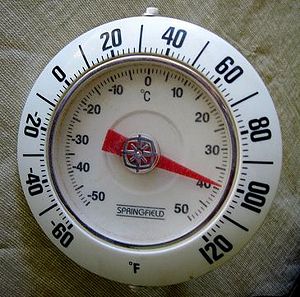Fahrenheit (unit): Difference between revisions
imported>Daniel Mietchen (pasted in from http://en.citizendium.org/wiki?title=Fahrenheit_and_Rankine_temperatures&oldid=100608182) |
imported>Daniel Mietchen (link to temperature conversion) |
||
| Line 9: | Line 9: | ||
A temperature interval of 1 degree Celsius is equal to an interval of 1.8 degrees Fahrenheit. | A temperature interval of 1 degree Celsius is equal to an interval of 1.8 degrees Fahrenheit. | ||
The different temperature scales can be transformed into each other by means of [[temperature conversion]], for which [[conversion table]]s and automated tools are available. | |||
Revision as of 18:00, 12 December 2009
The Fahrenheit scale is a temperature scale named after the German physicist Daniel Gabriel Fahrenheit (1686 − 1736), who proposed it in 1724. The symbol of a degree Fahrenheit is °F and the scale has now been largely replaced by the Celsius scale although it is still in use for non-scientific purposes in the United States.
In the Fahrenheit scale, the melting point of water (i.e., ice) at an atmospheric pressure of 101.325 kPa is 32 degrees Fahrenheit (°F) and the normal boiling point of water is 212 °F, placing those two reference points exactly 180 °F apart. Absolute zero in the Fahrenheit scale is −459.67 °F.
For comparison, in the Celsius scale, the melting point of water is 0 degrees Celsius (°F) and the normal boiling point of water is 100 °C, placing those two reference points exactly 100 °C apart. Absolute zero in the Celsius scale is 273.15 °C.
A temperature interval of 1 degree Celsius is equal to an interval of 1.8 degrees Fahrenheit.
The different temperature scales can be transformed into each other by means of temperature conversion, for which conversion tables and automated tools are available.
